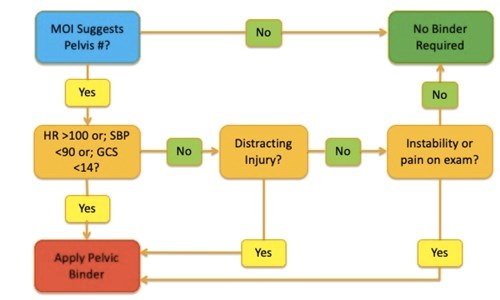Confirmation
Download PDF
Open All
PR02: Pelvic Binders
Applicable To
Introduction
If a pelvic injury is suspected, or there is a high mechanism of injury in an unconscious patient, the pelvis should be bound with a T-POD or KED. Binding the pelvis reduces overall pelvic volume and creates a tamponade effect, stabilizes fracture fragments reducing hemorrhage from the fracture sites, and improves patient comfort.
Pelvic binders should not be used for isolated neck-of-femur (NOF) fractures (also known as "hip" fractures).
Indications
Major mechanism suggestive of pelvic fracture with any of the following:
- Hemodynamic instability (heart rate > 100 or systolic blood pressure < 90 mmHg)
- Pelvic pain on exam
- Pelvic instability
- Decreased level of consciousness
- Major injury distracting from pelvic exam
Contraindications
- Neck-of-femur ("hip") fractures
- Falls from standing height or other simple falls
Procedure
- Remove the patient’s clothing. The T-POD should be in direct contact with the skin.
- Slide the belt under the supine patient and into position under the pelvis, aligning the centre of the belt with the greater trochanter.
- Trim the belt leaving a 15 to 20 cm gap over the centre of the pubic symphysis.
- Apply the Velcro tension straps.
- Slowly draw tension creating simultaneous, circumferential compression.
- Record the date and time of application.
- Secure the belts to ensure constant pressure without accidental release.
- If release is required, or occurs accidentally, the time of this event should also be noted.
- Document the application of the T-POD on the ePCR under 'Major Trauma: Intervention: Circulation.'
Notes


Resources
Numerous tutorial videos available online.